To celebrate the launch of the brand new Naked Oceans podcast, we venture beneath the waves to investigate the impacts of oil spills on the marine environment. We hunt down the hidden world of microbes in the Louisiana wetlands, trace the fingerprint of oil in the open oceans, and discuss the likely fallout from the Deepwater Horizon oil spill in the Gulf of Mexico. We'll also be exploring the effects of a changing climate on marine habitats, finding out what warmer water means for life at the poles and meeting some of Antarctica's unique marine wildlife. Plus, Carl Safina, President of Blue Ocean Institute explains why he would like to be a Bluefin Tuna!
In this episode
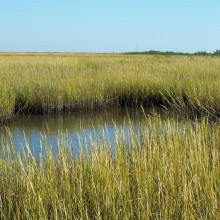
09:27 - Gulf of Mexico spill and the Louisiana wetlands
Gulf of Mexico spill and the Louisiana wetlands
with Robinson Fulweiler, Boston University
The issue of oil spills and the environmental problems they can unleash have barely left the news headlines over the past few months with events unfolding in the Gulf of Mexico, following the explosion on the Deepwater Horizon oil rig. As well as the potential impacts on marine birds, turtles, dolphins, and so on, there's a lot less obvious marine life that can also get hit hard with some really worrying consequences. To tell us more about the hidden side of oil spills, I spoke to Robinson Fulweiler from Boston University in the US...
Robinson - They're not as clean and pristine looking from the outside eye as something like a coral reef that you might go snorkelling on, but marshes and mangroves are full of amazing creatures. They are home to things like barnacles and sponges, fish and crabs, even muskrats and, of course, millions and millions of birds. In Louisiana, one of my favourite birds is the Roseate Spoonbill and this bird has a pale yellow head and then this beautiful white neck and the rest of it is all kind of hot pink. 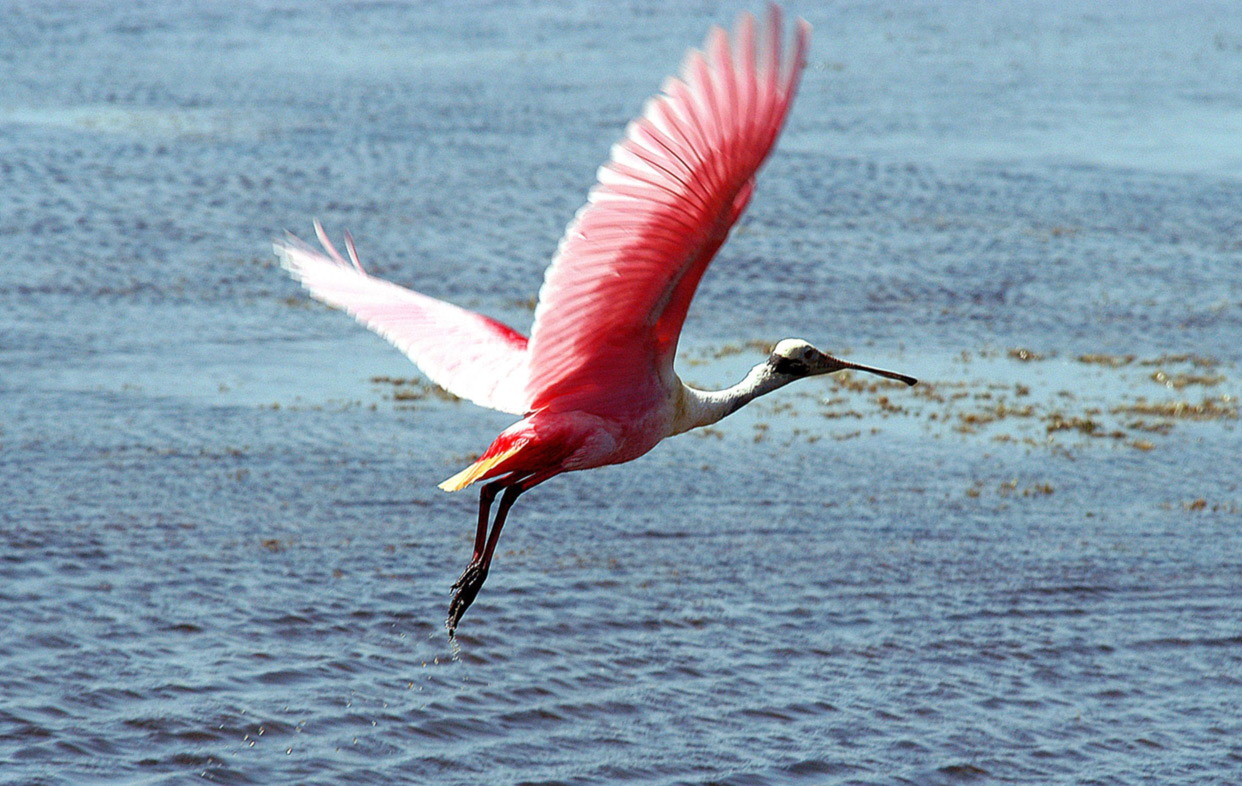 Beyond all of the visual things that we may like to see, [the wetlands] have a lot of things that are important that we probably don't notice offhand. They're a primary nursery habitat for lots of important fish species, both commercial, so things we like to eat and sell, and then they provide the homes for a lot of the base of the food web. And then they are important for things that we called 'ecosystem values' and these are much harder to quantify. So they do things like help us with flood mitigation; you can think of a wetland like a giant sponge. When you have lots of water coming in, these wetlands can soak up that water and help us with floods. Then both wetlands and mangroves are really important for storm abatement and stopping storm surges, and waves coming in. Even things like tsunamis, mangroves really are good at slowing down those kind of waves. I think that the thing that I'm probably most interested in is the idea of wetlands and mangroves being important for water quality. So, not only can you think of a wetland as a sponge, but you can kind of think of it as a giant filter too. There are lots of microbial processes that go on in wetlands that actually clean up our water.
Beyond all of the visual things that we may like to see, [the wetlands] have a lot of things that are important that we probably don't notice offhand. They're a primary nursery habitat for lots of important fish species, both commercial, so things we like to eat and sell, and then they provide the homes for a lot of the base of the food web. And then they are important for things that we called 'ecosystem values' and these are much harder to quantify. So they do things like help us with flood mitigation; you can think of a wetland like a giant sponge. When you have lots of water coming in, these wetlands can soak up that water and help us with floods. Then both wetlands and mangroves are really important for storm abatement and stopping storm surges, and waves coming in. Even things like tsunamis, mangroves really are good at slowing down those kind of waves. I think that the thing that I'm probably most interested in is the idea of wetlands and mangroves being important for water quality. So, not only can you think of a wetland as a sponge, but you can kind of think of it as a giant filter too. There are lots of microbial processes that go on in wetlands that actually clean up our water.
Helen - And in terms of that nutrient removal, how does that actually happen? Where do the nutrients go?
Robinson - You can think of it just like this: the water is flowing through the wetlands and it's bringing with it sediments and all these nutrients, and the sediment can get trapped in the plants themselves, in the leaves and the and the stalks. Then the nutrients can get taken up by the vegetation or by the microbial community that's living in those sediments. What they do there, the microbes use [the sediments] for energy, they're using them for food, and they convert them into their own biomass. So they actually can absorb these nutrients. One process that we are particularly interested in is something called 'denitrification.' In denitrification, there's a group of organisms that take nitrate which is NO3 and one of those nutrients that come in through fertilizer and waste water treatment. 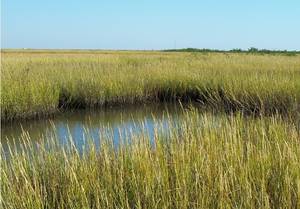 So, they take this form of biologically usable nitrogen, and what I mean by that is plants can use it and the microbes can use it, and they turn it into N2 gas. By doing that, they're essentially taking it from this usable form to a gas that's basically unusable to the majority of organisms on the planet. So they've actually removed it from the system and since humans add lots of nitrogen to the natural system in terms of fertilizer, we need these microbes to kind of clean up our act if you will.
So, they take this form of biologically usable nitrogen, and what I mean by that is plants can use it and the microbes can use it, and they turn it into N2 gas. By doing that, they're essentially taking it from this usable form to a gas that's basically unusable to the majority of organisms on the planet. So they've actually removed it from the system and since humans add lots of nitrogen to the natural system in terms of fertilizer, we need these microbes to kind of clean up our act if you will.
Helen - And what do we know about how oil contamination might affect those microbes? Is it toxic to them?
Robinson - It's one of those things where we're probably not 100% sure. Most of the work that's been done on looking at the effect of oil on denitrification has been done in the '80s or early '90s. They found that, in most cases, the oil was toxic to them but they weren't able to separate completely if it was a direct effect of toxicity to the cell itself or if it was because it changed the environmental conditions in which they live, and then made the habitat not ideal for them. So for instance when this process takes place, it's often important to take the sediments and mix it up and what I mean by that is that things like crabs make burrows and they burrow down into the sediment. When they do that, they are bringing fresh organic matter down with them and they're exposing this layer to oxygen. And when you put a layer of oil on top of a salt marsh, typically, we find it that crabs no longer burrow the way they normally do. Sometimes they just die outright and other times they simply stop their burrowing. And when you do that, you're changing this environment that the microbes are living in.
Helen - So presumably, if we see wetlands losing their ability to mop up nutrients, we could also see some of the existing problems in the Gulf of Mexico like the Dead Zone, get much worse.
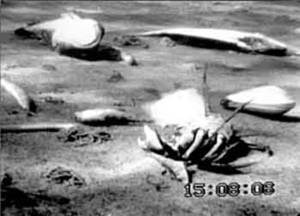 Robinson - Exactly. I saw a couple of days ago that they reported that the Dead Zone this year was one of the largest that's ever been, about 20,000 square kilometres - that's equal to the size of Massachusetts where I currently live, the State of Massachusetts. That's a huge Dead Zone and that's absolutely true - the thought there is that the Mississippi used to flood every year and flow over to the banks and then it would allow the sediment and nutrients to go in to the marsh and the marsh could do its nutrient filtering thing that it does so well. Plus, we had a lot less nitrogen coming in at that point before we levied the Mississippi river. But now, we keep the river sort of on a pipe, all the way to the coast and we don't allow it to overflow into the marsh. We've cut off this natural filtering capacity. So, it's bad for the marsh because it needs nutrients and sediment to grow and we don't give it that anymore. And then it's bad for the coastal area in the Dead Zone because we're directly transporting this nutrient rich water from all of the farm belt in the US out into the Gulf of Mexico.
Robinson - Exactly. I saw a couple of days ago that they reported that the Dead Zone this year was one of the largest that's ever been, about 20,000 square kilometres - that's equal to the size of Massachusetts where I currently live, the State of Massachusetts. That's a huge Dead Zone and that's absolutely true - the thought there is that the Mississippi used to flood every year and flow over to the banks and then it would allow the sediment and nutrients to go in to the marsh and the marsh could do its nutrient filtering thing that it does so well. Plus, we had a lot less nitrogen coming in at that point before we levied the Mississippi river. But now, we keep the river sort of on a pipe, all the way to the coast and we don't allow it to overflow into the marsh. We've cut off this natural filtering capacity. So, it's bad for the marsh because it needs nutrients and sediment to grow and we don't give it that anymore. And then it's bad for the coastal area in the Dead Zone because we're directly transporting this nutrient rich water from all of the farm belt in the US out into the Gulf of Mexico.
Helen - Now we passed the 100-day mark after the Deepwater Horizon explosion and there was a lot of talk about how the spill was perhaps not such a terrible ecological disaster as we'd all feared initially. Do you think we should still be concerned about the impact of oil in the region?
Robinson - Absolutely. I think the first is that Louisiana's wetlands have been in trouble for a long time and the last thing that they needed was this oil spill. We lose an area of wetland about the size of a tennis court every 30 seconds or so in Louisiana. Because of how the system is set up, it's losing a lot of salt marsh to sea level rise. Plus, we've already gone in there and done things like we put a lot of piping for the oil and gas industry underneath the salt marsh so that's disrupted it. We've removed things like water and gas from underneath the salt marsh, underneath the wetlands, so they're actually sinking. And then we had things like hurricane Katrina that came in and really caused some serious damage. Plus, as I mentioned, this fact that we've disconnected the wetlands from the river and this natural process that helps build them. So the wetlands are already in big trouble down there and the last thing they certainly needed was this oil spill. I think that we all keep our fingers crossed that the oil spill is not a disaster and that it would go away, and wouldn't be a problem. But I think that it's much too early to say that. If we look at some of the work that the people have done on some of the big oil spills like the Exxon Valdez oil spill, a lot of the acute effect seems to go away relatively quickly. So, a lot of birds and mammals died and then we didn't see anything and so I think people tend to think it's okay, but there are issues with chronic low level exposure to oil. We could see that certainly in Louisiana and there's a recent report saying that some of the blue crab larvae actually had oil attached to them. And when larvae are exposed to hydrocarbons, they can actually have mutations and become deformed. A scientist I read in the newspaper the other day said that a deformed larvae is just as bad as a dead larvae. I think we definitely hope that it's not going to be as bad as we all imagined, but I think it's much too early to say that.
Helen - That's Robinson Fulweiler from Boston University, talking about the Louisiana wetlands and the crucial hidden world of microbes.
Find out more
Oil and oil spills: the Gulf of Mexico. Marine science review (papers from 30 years of oil spill studies). Sea Web (PDF) Robinson Fulweiler.
Assistant Professor, Department of Earth Sciences, Boston University
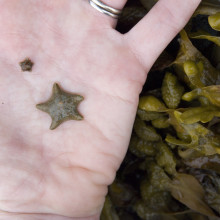
18:49 - Catching up with the Sea Empress Oil spill
Catching up with the Sea Empress Oil spill
with Robin Crump
On February 15th, 1996 at 8 PM, the Sea Empress oil tanker ran aground just off the coast of Pembrokeshire in Southwest Wales. In the week that followed, 70,000 tons of North Sea light crude oil spilled out and it affected 120 miles of shoreline and some of the UK's most important and biodiverse coastal habitats. The oil killed tens of thousands of sea birds and affected 26 protected areas known as Sites of Special Scientific Interest or SSSIs. I went to West Angle Bay, one of the worst hit beaches to meet local ecologist, Robin Crump, to find out more about how the coastline is getting on, 14 years after spill...
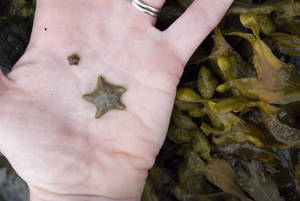 Robin - Well, if you look on the underside of this stone, you'll see that there are two starfish here. One is the big green one which is Asterina gibbosa, the common one and it's commonly found on the shore. And then there's a little tiny one here. Can you see? It's dark green with a chocolate brown substar on the back. This is a very rare species called Asterina phylactica and a colleague and I described it as a new species in 1978. You can imagine how I felt when I came down here the morning after the spill and found these rock pools completely covered in 10 centimetres of North Sea crude oil. All the pools were affected. The upper shore pools were almost pure oil. The ones with the starfish in had a surface layer of oil which completely covered them and I really thought they'd all be killed. In fact, something strange happened. Only the small Asterina phylactica, the rare one, turned out to be very susceptible to oil and all but five died. By June, we could only find 5 animals left. Whereas, only the baby Asterina gibbosa died and the adults of Asterina gibbosa, the common one, then laid eggs and it was a huge population explosion. So one benefited from the oil and the other one was almost wiped out. Now this Asterina phylactica is very rare and at that time there were only 6 sites for it in Britain. We were very concerned to try and ensure that it survived and so I carried on monitoring the pools every month. In June after the spill, I took one animal which was sitting on eggs, it already laid its eggs and was brooding them, took it on its stone into the lab. It hatched out 50 babies. I put them back and it's never looked back. The species now is more common than it was before the spill, just with a little help from its friend. Asterina gibbosa interestingly, as the numbers of Asterina phylactica grew to nearly a thousand, gibbosa became less and less common and there is intense competition between these two species for space on the shore. But at least the species have survived at this site. And because it became quite famous over the oil spill, people have looked for it elsewhere and there are now 20 or 30 sites for it in Britain.
Robin - Well, if you look on the underside of this stone, you'll see that there are two starfish here. One is the big green one which is Asterina gibbosa, the common one and it's commonly found on the shore. And then there's a little tiny one here. Can you see? It's dark green with a chocolate brown substar on the back. This is a very rare species called Asterina phylactica and a colleague and I described it as a new species in 1978. You can imagine how I felt when I came down here the morning after the spill and found these rock pools completely covered in 10 centimetres of North Sea crude oil. All the pools were affected. The upper shore pools were almost pure oil. The ones with the starfish in had a surface layer of oil which completely covered them and I really thought they'd all be killed. In fact, something strange happened. Only the small Asterina phylactica, the rare one, turned out to be very susceptible to oil and all but five died. By June, we could only find 5 animals left. Whereas, only the baby Asterina gibbosa died and the adults of Asterina gibbosa, the common one, then laid eggs and it was a huge population explosion. So one benefited from the oil and the other one was almost wiped out. Now this Asterina phylactica is very rare and at that time there were only 6 sites for it in Britain. We were very concerned to try and ensure that it survived and so I carried on monitoring the pools every month. In June after the spill, I took one animal which was sitting on eggs, it already laid its eggs and was brooding them, took it on its stone into the lab. It hatched out 50 babies. I put them back and it's never looked back. The species now is more common than it was before the spill, just with a little help from its friend. Asterina gibbosa interestingly, as the numbers of Asterina phylactica grew to nearly a thousand, gibbosa became less and less common and there is intense competition between these two species for space on the shore. But at least the species have survived at this site. And because it became quite famous over the oil spill, people have looked for it elsewhere and there are now 20 or 30 sites for it in Britain.
Helen - So Robin, you know these shores probably better than anyone else. You've been here, studying these shores for decades but you were also here to study the changes after the oil spill, and quite an interesting story unfolded and an essential character were these chaps, the limpets. Can you tell us more about that?
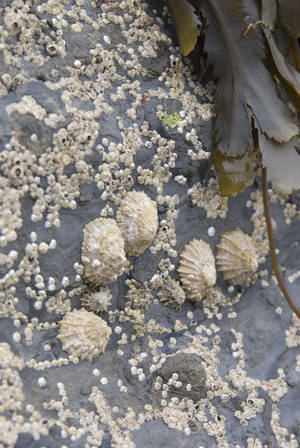 Robin - Well that's right. We often called a limpet 'the rabbit of the shore' because limpets graze across the surface of the rocks. You can actually see their feeding marks here on the rock, the zigzag trail of scratches where they're scraping off the algae. Now, they're also very susceptible to oil. They're not generally killed by it but it sends them to sleep. So they relax their hold, fall of the rocks, and then either the gulls come down and eat them - oyster catchers had a field day! - or they get washed away by the waves and die that way. There was a huge mortality of limpets here at West Angle Bay. It was the most important effect of the spill from an ecological point of view because once you remove the limpets it gives free reign for the seaweeds to grow. This shore you're looking at here, if you look along, you'll see it's grey-white now with limpets and barnacles. But six months after the spill, it was completely covered in green algae which had come in and there were just not enough limpets left to eat it off. The next year, in came the brown algae and you had a lovely thing called Fucus versiculosis variety linearis, the bladderless bladder wrack, which covered the whole shore, all the way through the middle shore and that of course then acted as a habitat for other animals. So you've got flat periwinkles, and other things which never normally grow on these exposed outer shores in Pembrokeshire, suddenly coming in and invading this new ecosystem. So by removing one keystone species, the limpet, you actually affect the whole ecosystem.
Robin - Well that's right. We often called a limpet 'the rabbit of the shore' because limpets graze across the surface of the rocks. You can actually see their feeding marks here on the rock, the zigzag trail of scratches where they're scraping off the algae. Now, they're also very susceptible to oil. They're not generally killed by it but it sends them to sleep. So they relax their hold, fall of the rocks, and then either the gulls come down and eat them - oyster catchers had a field day! - or they get washed away by the waves and die that way. There was a huge mortality of limpets here at West Angle Bay. It was the most important effect of the spill from an ecological point of view because once you remove the limpets it gives free reign for the seaweeds to grow. This shore you're looking at here, if you look along, you'll see it's grey-white now with limpets and barnacles. But six months after the spill, it was completely covered in green algae which had come in and there were just not enough limpets left to eat it off. The next year, in came the brown algae and you had a lovely thing called Fucus versiculosis variety linearis, the bladderless bladder wrack, which covered the whole shore, all the way through the middle shore and that of course then acted as a habitat for other animals. So you've got flat periwinkles, and other things which never normally grow on these exposed outer shores in Pembrokeshire, suddenly coming in and invading this new ecosystem. So by removing one keystone species, the limpet, you actually affect the whole ecosystem.
Helen - But the limpets came back?
Robin - Oh yes! Well limpets have planktonic larvae and so, the next year, once the oil had been washed up more or less by the waves, then you got a resettlement of young limpets coming in. But another interesting thing was that the few limpets that had survived grew to enormous size because they had a huge amount of food each. Normally, they're kept small because they're half starved but because there was so few of them, they got to - well some of the biggest limpets in Britain - 7 centimetres long! But then you had a lot of young limpets coming in, settling in amongst the base of the seaweed. After about 4 years, the seaweed dies anyway of old age and is smashed off the rocks by the waves and then the limpets begin to grow and grow, and now, we're back to a situation where most of the limpets here you'll see are quite small, perhaps only 2 centimetres long.
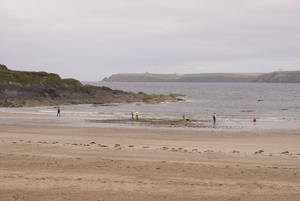 Helen - So with your expert eyes, can you look at the shore and see a fingerprint of the oil spill or does it really look much as it did 14 years ago before this all happened?
Helen - So with your expert eyes, can you look at the shore and see a fingerprint of the oil spill or does it really look much as it did 14 years ago before this all happened?
Robin - It's quite incredible to me, the way the shore has recovered. I'll be honest, when I stood here 14 years ago, I thought it was the end of my teaching career here because we use this all the time. Not a bit of it. In fact in some ways, the shore is almost richer now than it was, for some species, than it was before the spill. Generally speaking, looking around you, the shore looks very much as it did before the spill happened. Having said that of course, we don't know about genetic effects on organisms or possibly tiny trace elements of poisons which may still be in the system, but to the naked eye, and to an amateur biologist like me, it looks just as good as it's ever done.
Helen - Well it was really good to see how thriving the coastline is after such a potentially dreadful disaster. And actually, a lot of people are saying it was really lucky that things weren't an awful lot worse. That was Robin Crump, former Head of the Orielton Field Research Centre in Pembrokeshire, introducing me to some of the survivors of the Sea Empress Oil Spill.
Find out more
Robin Crump et al (2003).
West Angle Bay: a case study. The fate of limpets. Field Studies. (PDF)British Marine Life Study Society information about the Sea Empress oil spill
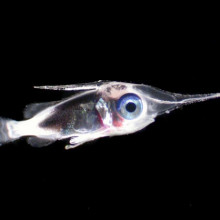
26:20 - Tracing the effects of oil in the open ocean
Tracing the effects of oil in the open ocean
with Amy Hirons, NOVA Southeastern University
Sarah - Oil spills don't just affect the shorelines that they wash up on. It can also cause important changes out at sea. I spoke with Amy Hirons from Nova Southeastern University in Florida to find out about the effects of oil in the pelagic realm.
Amy - Well I'm a Biological Oceanographer and my interests really stem with looking at how ocean production or food is transferred from the smallest organisms, the phytoplanktons, the plants, and the zooplankton, the animals, and how that's passed through the food web in the ocean all the way to apex predators - things like sharks and whales and dolphins. The method that I used is utilizing stable isotope ratios. A lot of people understand, or at least have heard of, radio isotopes which naturally decay over time, such as carbon-14 which can be used for dating.  A stable isotope is somewhat similar except that it doesn't decay and so it's used as a natural tracer. There are stable isotopes of many elements such as carbon and nitrogen. So I can actually take a piece of tissue or bone or sediment and combust the sample. I use a mass spectrometer then to look at the ratio of heavier and lighter isotopes such as carbon or nitrogen. That allows me to look at how carbon and nitrogen, which are composed in our food, is then passed through a food web. That provides this information on many different levels. One, basically, [with nitrogen] who's eating whom? Carbon can actually give us information about geographic location. If an organism is found in the near shore in the estuarine environment versus offshore in the pelagic, or whether it's pelagic in the open water versus benthic on the ocean floor.
A stable isotope is somewhat similar except that it doesn't decay and so it's used as a natural tracer. There are stable isotopes of many elements such as carbon and nitrogen. So I can actually take a piece of tissue or bone or sediment and combust the sample. I use a mass spectrometer then to look at the ratio of heavier and lighter isotopes such as carbon or nitrogen. That allows me to look at how carbon and nitrogen, which are composed in our food, is then passed through a food web. That provides this information on many different levels. One, basically, [with nitrogen] who's eating whom? Carbon can actually give us information about geographic location. If an organism is found in the near shore in the estuarine environment versus offshore in the pelagic, or whether it's pelagic in the open water versus benthic on the ocean floor.
Sarah - So, by tracing the carbon isotopes, you're effectively tracing the impacts of oil spills through the food chain.
Amy - Yes and by working with environmental chemists who can look at various fractions of the petroleum product itself and then comparing that to the same kind of components of cells of fish and invertebrates and plankton, we can determine if certain components of petroleum are truly being incorporated physiologically in an organism and then being passed on through the food web. Then we can follow any kind of detrimental impact, certainly looking at an organism directly and at cellular structures, but also by looking at population numbers and community structures. Previous work that I did after the Exxon Valdez oil spill in Prince William Sound, Alaska, indicated that, for many different organisms, there were different impacts. Certainly, there was the external: the direct impacts of reduced primary production because the phytoplankton wasn't able to stay in the water column and photosynthesise. But then there were fish that developed ulcers and tumours. There were decreased numbers of populations of various organisms such as steller sea lions and harbour seals that we began to be concerned that this carbon and other elements or other components of petroleum products were actually being incorporated and damaging the cells of these organisms. Our major concern right now is that we don't have a lot of information about some of the detrimental impacts, particularly at the base of the food web, in the phytoplankton and the zooplankton.
Sarah - And of course, it's not just the oil that's having effects. It's how we're dealing with the oil as well. Is that right?
Amy - That's correct. Many oil companies use a chemical dispersant to help break apart the oil, much like a dish detergent is added to a sink full of dirty dishes that may have oil deposits to help break apart the oil or the little globs. So BP has been using their own chemical dispersant called Corexit and they've been releasing it at the source of the well from the Deepwater Horizon. What most people don't know, as far as I am aware, is what impact that dispersant is actually going to have on the cellular level of different organisms. So where we've been talking about the potential impact of petroleum and how it's traced through the food web, we don't know about the chemical dispersant and that also could be having a detrimental effect to a degree that we just don't know. One thing we're trying to do right now is - there are many different researchers out in different platforms out in the Gulf of Mexico, all the way down into the Florida straits and in the areas of the Florida Keys, collecting water samples, collecting microscopic organisms, looking and doing counts of the larger fish and invertebrates, trying to determine: have their population numbers changed? So, is there a detrimental impact that could be killing the organisms or damaging the organisms outright, or is it something that can also be perpetuated through the food web, through bioaccumulation in the tissues? We don't know that and that has to be studied.
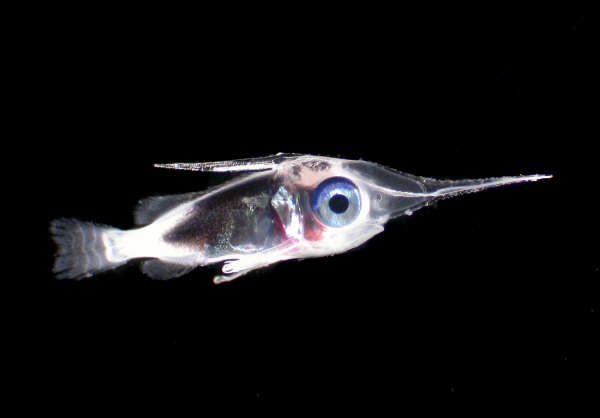 Sarah - So what do you think, with the spill in the Gulf of Mexico, do you think we're going to be seeing the impacts in the accumulation of the oil from that in seals, sea birds, that sort of thing in years to come?
Sarah - So what do you think, with the spill in the Gulf of Mexico, do you think we're going to be seeing the impacts in the accumulation of the oil from that in seals, sea birds, that sort of thing in years to come?
Amy - I absolutely believe that to be the case based on what we've seen in other locations like Prince William Sound. Another serious impact that the oil can have is not just on the phytoplankton and zooplankton, but juveniles - those organisms that have recently been hatched or spawned. The time of the oil spill from the Deepwater Horizon was also similar timing to when many organisms actually spawn. The water column is now full of developing ichthyoplankton or baby fish that may be impacted. We may lose year classes of fish or invertebrates. We just don't know at this point. It's just too early to tell.
Sarah - I suppose you see on the news the impacts with sea birds and the large sized animals, but people don't necessarily think about the impact on the microscopic life out in the open ocean.
Amy - Oftentimes, my concern is that people have this out-of-sight, out-of-mind feeling about oil or an oil spill. People tend to not think about what they can't see. That's human nature I believe. "Oh, we've cleaned it up. Oh, we don't see tar balls anymore. We don't see evidence of an oil slick." But the fact is, just because you can't see it with the naked eye doesn't mean it's not still in the environment, either the deep ocean, in the benthos, being incorporated and continually being reutilised. And again, I've repeated it several times, they're at the base of the food web. Without the phytoplankton and the zooplankton, you don't have anything else in the ocean and that's why it's critical for us to find out what the impact of petroleum products are having.
Find out more
Amy Hirons.
Research Professor, Oceanographic Centre, NOVA Southeastern University
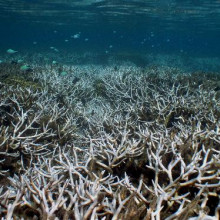
34:34 - Climate change rundown
Climate change rundown
with John Bruno, University of North Carolina, Chapel Hill
Climate change poses many, varied threats to the oceans. John Bruno gives us a rundown of findings from his recent review of the topic in the journal Science...
John - It's surprising how quickly this is all happening. I thought I would mostly spend my career warning people about the dangers of future climate change but it's happening so quickly that I'm actually witnessing it and probably will spend half my career studying it.
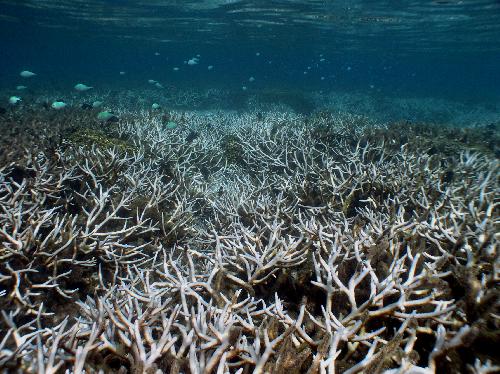 Helen - So, what kind of changes are you seeing happening in the oceans?
Helen - So, what kind of changes are you seeing happening in the oceans?
John - We're seeing first very simple changes - animals simply dying when the water get too hot. Corals and many other animals have very specific thermal thresholds so they can only tolerate temperatures either too warm or too cold to a certain degree. If summer time water temperatures get about a degree Celsius, or a little bit more, warmer than as usual, that can kill corals. Then, of course, once the corals die, the rest of their reef really degrades because so many fish and invertebrates depend on the corals. But I think the really interesting thing from our review article was how many other more fundamental, but in a lot of ways less visible, changes are occurring as a result of climate change generally, and ocean warming in particular. So it's not as simple as "warming happens, animal dies". That's pretty simple and that's, I think, what scientists have been looking for and what the public probably expects.
But there are far more fundamental changes, for example in processes. So we know from experimental evidence that things like larval development and metabolism are very sensitive to temperature. It's a very difficult thing to actually measure in the field, but there are some related phenomena from this broader field of science called the metabolic theory of ecology that we are seeing. For example, plankton in the North Atlantic are getting smaller and that's exactly what the metabolic theory of ecology predicts. The warmer the temperature, the smaller the organisms, so we're seeing both phytoplankton - the small plants - to zooplankton - the animals that eat them - getting smaller and smaller. Part of that is selection for smaller individuals within the species and part of that is a replacement of larger-bodied species by smaller-bodied species.
Helen - And we're talking phytoplankton, we're talking changes there are going at the base of the foodweb which will presumably ripple all the way through the ecosystems.
John - That's right. Those changes might sound not so profound - okay, so phytoplankton gets smaller - but here's two really big implications. One is that it reduces the efficiency of what's called the "carbon pump". That is the rate at which the ocean ecosystem in the middle of the ocean extracts carbon dioxide and essentially moves it down into the deep water. That happens when phytoplankton die, they sink down to the bottom, and then that carbon in their bodies effectively gets stored for a long time. That's a really useful thing for us right now because it's mitigating some of the carbon dioxide that we're putting into the atmosphere.
There's another interesting implication for fisheries. The transfer of energy from one trophic level to another, for example from plant to herbivore or from herbivore to carnivore, is very inefficient: only about 10% of the energy from a plant for example makes it into the herbivore and that's true all the way up the food chain. So the smaller the plants are, you end up adding another trophic level to the food chain and what that does is reduces the biomass in productivity of the species that we're fishing. So, we're predicting that we're going to start seeing reduced production of the carnivores that we like to catch and eat.
Helen - Which of those things is worrying you the most?
John - I find that change in species distributions both worrying and also, frankly, quite interesting. We're seeing rapid range shifts of tropical and temperate species away from the equator into northern waters. There's really good evidence from long term monitoring projects that that's happening in the North Atlantic and it's true for phytoplankton and zooplankton, as well as for fish. So again, these tropical species are moving northward as the oceans warm. A study came out in the journal [Global Change Biology] by Fodrie et al. It's open access so anybody can go look for it. They had a time series of what fish were present in the Northern Gulf of Mexico in the 1970s and they went back to the same sites and used nets to catch all the fish to figure out what was there now. Really surprisingly, they found that there was about 15 new species that had moved north, primarily from the coral reefs in the Yucatan Peninsula and had invaded salt marsh and sea grass environments now in the Northern Gulf of Mexico. It's primarily due, we think, to the warming that they've seen there: about 5 to 7 degrees Fahrenheit, or 2 to 3 degrees Celsius, of warming over the last 30 years. It's a really interesting phenomenon because now a whole new suite of predators and herbivores are being exposed to prey species, both plants and fish, that have no evolutionary history with them. So there's really no co-evolutionary history between predator and prey.
Helen - So, warming oceans are already profoundly mixing up life in the sea as we know it. There's lots to think about there.
Find out more
John's Science review
Ove Hoegh-Guldberg & John F. Bruno (2010). Impact of climate change on the world's marine ecosystems. Science DOI: 10.1126/science.1189930
Bruno lab
Marine Ecology & Conservation in Carolina.
Fodrie et al (2010).
Climate-related, decadal-scale assemblage changes of seagrass-associated fishes in the northern Gulf of Mexico. (PDF) doi: 10.1111/j.1365-2486.2009.01889.x
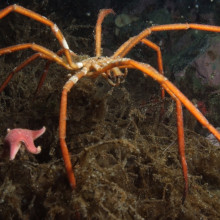
40:42 - Climate change in Antarctica
Climate change in Antarctica
with David Barnes, British Antarctic Survey
Some of the fastest changes due to warming seas are taking place in the Southern Ocean. David Barnes from the British Antarctic Survey tells us about studying in the coldest place on the planet and we meet some amazing critters that have come a long way from home.
David - I think most people know that Antarctica is the coldest place on Earth, but what they don't realise is that it's the driest, the windiest, and the highest place on Earth, and all of these are very important to the biology. It has no invasive species, so no species that aren't supposed to be there in the sea. Its native fauna - the animals that have always lived there - occur nowhere else on Earth. 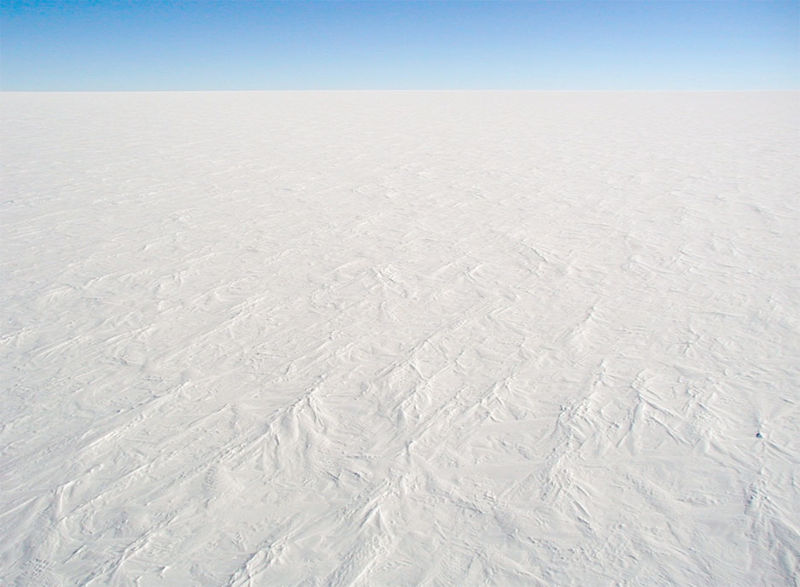 They are incredibly sensitive to some things like temperature change and this is one of the fastest changing parts on the planet, and one of the parts of the planet that affects most others because, of course, ice turns into water that raises sea level. We can look back at the way that planet has responded to changes in the past and that record is preserved in the animals there. So, that's why we go south to look at many of the animals and what they can tell us about our planet.
They are incredibly sensitive to some things like temperature change and this is one of the fastest changing parts on the planet, and one of the parts of the planet that affects most others because, of course, ice turns into water that raises sea level. We can look back at the way that planet has responded to changes in the past and that record is preserved in the animals there. So, that's why we go south to look at many of the animals and what they can tell us about our planet.
Sarah - So what sort of changes have you seen already out in the field from the results that you've got?
David - I've been going down to Antarctica now since about 1990 and in that time, there have been some really profound changes - particularly in the Bellingshausen Sea which is around the Antarctic peninsula. There, it's got quite a lot warmer only in the surface layers, but it's made a big difference: a degree of temperature there doesn't sound much here, but you remember that in the last 4 ½ million years, the annual temperature variability is about 3 degrees. Now that seems tiny when we might get that sort of temperature variation in a month around the UK.
So, big temperature changes on land and in the sea, a lot of sea ice has been lost around the Bellingshausen Sea as well and that's important for several things. When the sea changes from white to blue, it absorbs a lot more heat and that means that our planet is warming up and an astronaut on a space station would see that change dramatically. That means that there's a lot more sea open and getting a lot more light so phytoplankton is making a lot more food. That helps us because that's taking carbon dioxide out of the air and into the water and perhaps sequestering it down to the sea bed, getting rid of it. So how's the biology reacting to all this? Well, more food means that there are new possibilities for some animals but also because the sea ice is retreating further south, animals, too, are retreating further south so we're seeing range shifts in where organisms occur.
Sarah - So in the field we're seeing range and productivity shifts, but the team can also learn a lot more about the animals by bringing them on the 7,000-mile trip back to Cambridge...
...
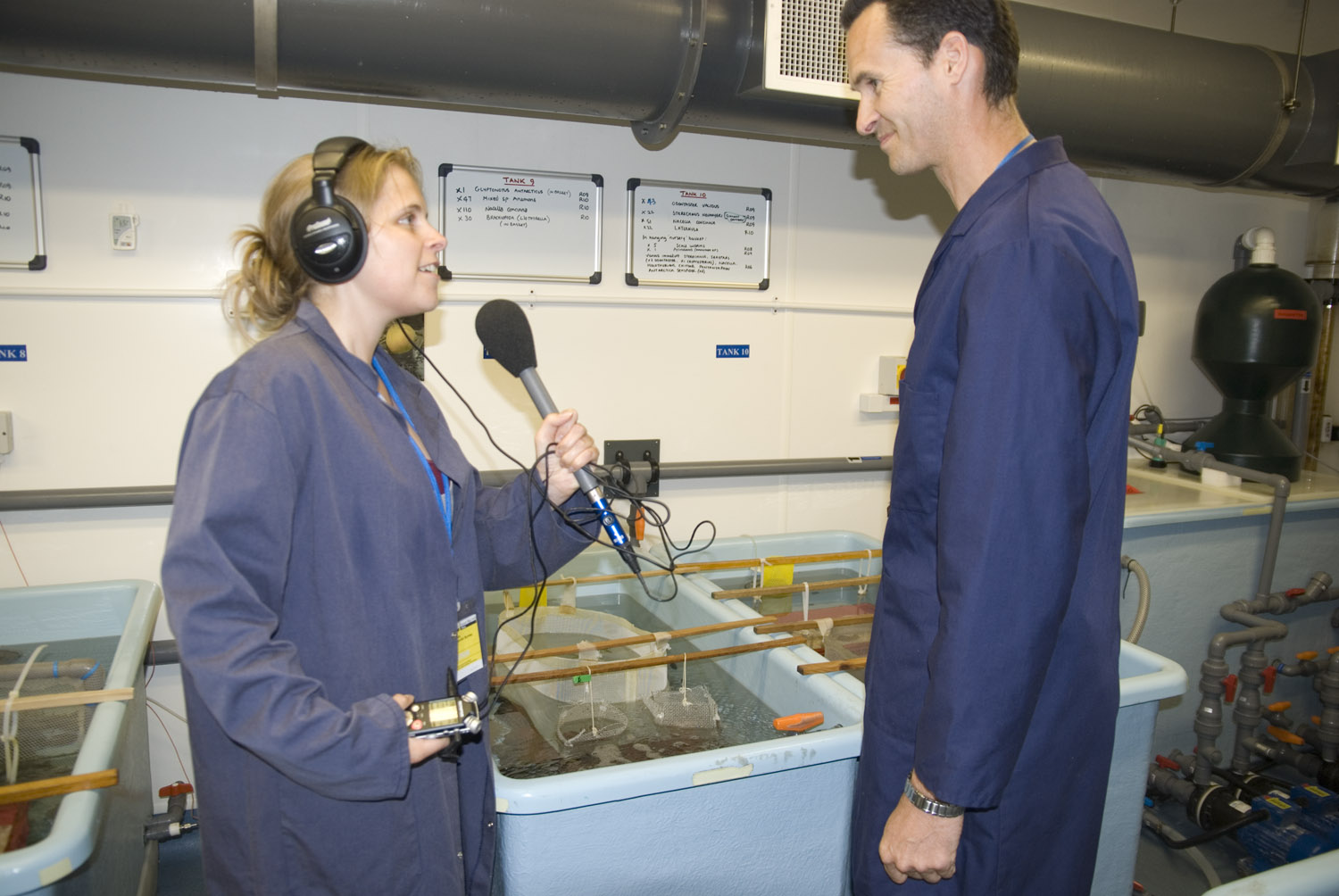
Sarah - ...So we're just heading into the cold room now. We've got to put on some lab coats, not just to keep us warm but to stop all of our external stuff getting all over your precious samples. Is that right?
David - Yes, that's right and we're going to tread on a mat that's going to kill anything on our feet when we walk in to this sealed aquarium facility.
Sarah - Gosh! It really is quite cold in here. We've got about 10 tanks absolutely choc-full of things, we've got star fish, anemones... Why bring them back at all? I mean, it seems like a lot of effort.
David - Yes, it is a lot of effort and it's very costly in time and expense. But there's lots of work we can do here, particularly with respect to genetics and the physiology - looking at the detailed measurements. We need carefully controlled experimental facilities that we have in labs here. One of the things that we've been doing with some of the animals here is that we've been manipulating the acidity of the water, which is projected to change a lot over the next 100 years, just by tiny amounts and seeing whether that fundamentally alters their ability to build skeletons, and to maintain their skeletons. It's more tricky building and maintaining a skeleton in Antarctic waters. Changing the acidity there by a tiny amount will make a bigger difference than elsewhere so we can manipulate those changes that are likely to happen in tens of years, in months here. And these are our model organisms that we have been very carefully making tiny, tiny changes to, and looking at the response that they give.
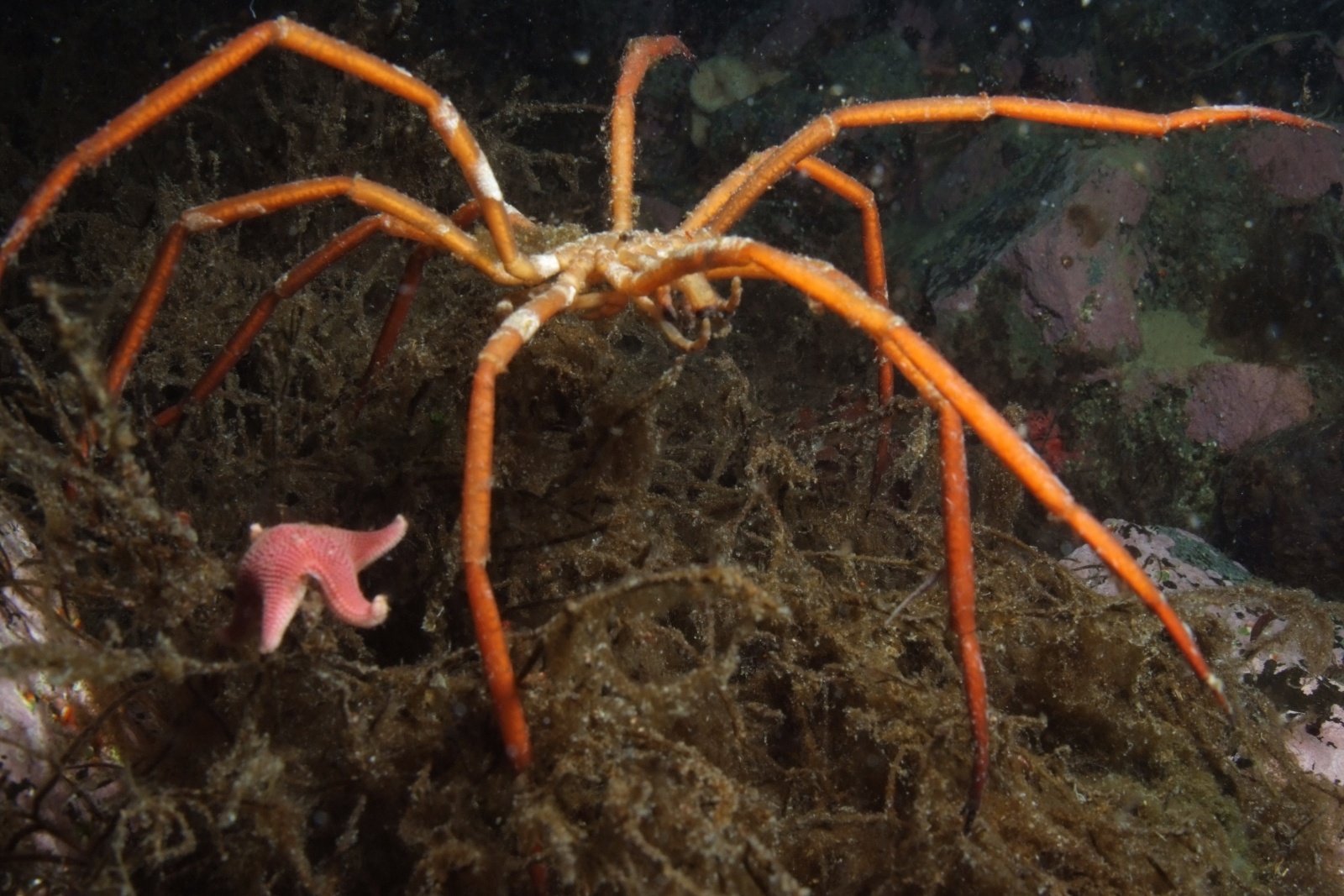 Sarah - Oh my God! That sea spider is huge. It's almost the size of a dinner plate. That is massive.
Sarah - Oh my God! That sea spider is huge. It's almost the size of a dinner plate. That is massive.
David - This very cold water holds a lot of oxygen so some animals can reach gigantic sizes. If we look into this aquarium here, we can see two sea spiders that are the size of my outstretched palm and that's because these raised oxygen levels mean that it's much easier to get oxygen to their tissues. Sea lice and comb jellies also reach gigantic sizes in polar waters.
Sarah - Right. Well it's getting a bit chilly in here so I think that we should probably get back to the office and leave your beasties in peace...
...
Sarah - ...So David, what do you think are the changes that we are likely to see in Antarctica in the future?
David - I think we're going to see areas like the Scotia Sea and the Bellingshausen Sea getting much warmer. We're going to see more sea ice loses and so even more heat being absorbed by blue ocean. There's going to be a lot of phytoplankton production. We're going to see collapse of ice shelves which is going to be dramatic because they tend to happen very quickly, exposing large areas of sea bed that we have never seen that will gain whole new communities of life that will take down carbon. We're also going to see dramatic changes in the acidity that might fundamentally affect whether organisms are able to maintain skeletons or not. Things like that could really re-shape the planet. Our problem is knowing how fast these things are going to happen. With many of these we've been surprised even at the pace of things in the last 10 years: typically, things are happening faster than we thought they would.
Sarah - And what do you think that the changes in Antarctica can tell us and will mean for the ocean system and global climate system as a whole?
David - Because it's got the most unstable large ice masses, global sea level rise will be dictated by what goes on in Antarctica, but it also drives the world's ocean circulation system: the thermohaline circulation system. Sinking water masses, the rate of sinking, and the rate of outflow from Antarctica, distributes oxygen and ocean current speeds and direction around the planet. Small changes in the oceanography there have a big deal of difference in the Atlantic and the Pacific.
The way that biology responds there is going to be our early warning system on the way that life is going to respond elsewhere. In Antarctica, things are changing faster but also, because life is more sensitive there, it's giving us a state of things to come elsewhere. It will be a problem to some biodiversity; it won't to others. There will be winners and losers but I think we will be the biggest losers out of climate change. Most people and most industry live on the coast. We're going to lose a lot of coastal land and of course, deserts are expanding very quickly and the water table going down dramatically in many places means that we're going to face big migration issues. People aren't going to be able to get enough water and they're going to lose their land. Lots of people are going to be very crowded for very little resources. So yes, climate change is a big issue for us and Antarctica is going to shape our future.
Sarah - So clearly, there are many extremely important changes happening already in Antarctica with big implications for the rest of the world.
Find out more
Climate change in Antarctica.
British Antarctic Survey
David Barnes et al (2009).
Geographic range shift responses to climate change by Antarctic benthos: where we should look?. Marine Ecology Progress Series. (PDF)
David Barnes & Lloyd Peck (2008).
Vulnerability of Antarctic shelf biodiversity to predicted regional warming. Climate Research (PDF)
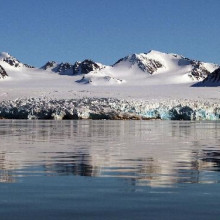
49:11 - Life in Arctic Sea Ice
Life in Arctic Sea Ice
with David Thomas, Bangor University
As well as big animals like polar bears that hunt on top of Arctic sea ice, there is an extraordinary world of life living in the ice itself. David Thomas introduces these vanishing ecosystems and the challenges of studying them before they are gone...
David T - It's been very clear for the last 5-6 years or so that we really do have shrinking summer sea ice in the Arctic. This means that ice that normally lasted throughout many seasons is now almost totally disappearing in the summer. This is in contrast to the total ice in the Arctic in the winter period which is about the same extent as it's always been. When people in the media talk about Arctic sea ice loss, they're really talking about loss of sea ice in the summer months. There are predictions - the most catastrophic is that by 2013 there will be no ice in the Arctic basin in the summer. A more conservative estimate is that in the next 100 years there will be no ice in the Arctic basin in the summer. But there will always be Arctic sea ice in the winter and this is one of the things that tends to be forgotten. We are talking about long lasting ice rather than total ice extent in the Arctic. 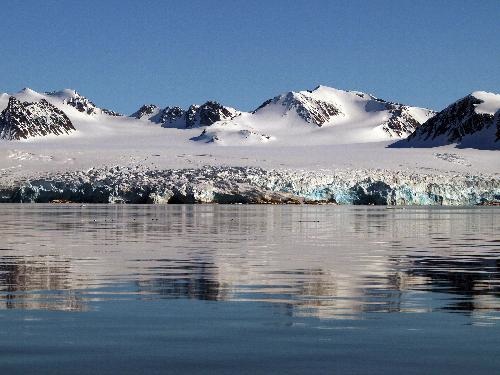
So one of the consequences of there being less summer ice, and this is what the Arctic was renowned for in the past: having thick ice flows of 10 metres thick. This thick ice is actually going, so that the mean thickness of the ice in the Arctic Ocean is going down dramatically. One of the consequences of ice going is that especially snow covered ice reflects a lot of solar radiation and sea water, which is rather a dark body, absorbs radiation. So one of the things that's happening with Arctic sea ice is as there's getting more and more open water, more and more heat is absorbed, and this is actually increasing the rates, or is thought by some to be increasing the rate, of the melting of the Arctic ice.
Helen - We hear a lot about polar bears and walruses being the wildlife that suffer as Arctic summer ice disappears, but there's a lot more going on, not just at the top of the food web. What do we know about life under, and even in, the sea ice and why is it important?
David T - Sea ice was often thought to be a desert that's void of all life. We now know that there's actually a myriad of organisms from viruses to small crustaceans that live within the ice itself. There's a whole host of other, larger organisms that live in this very narrow band of the ice-water interface on the peripheries of ice flows and there's a host of organisms that are eating on the ice biology and the organisms of the ice-water interface like fish or larger crustaceans that are the basis of the food web for the seals and the more charismatic polar bears. So, there's a whole host of different habitats and whole ecosystems that are provided by sea ice, that are in turn are of a food source for the major charismatics that maybe catch the attention of the media a little bit more.
Helen - Presumably, we still have an awful lot left to discover about these sea ice ecosystems. There must be a lot of things we still don't know.
David T - I think it's right that sea ice research and the research into the organisms living in sea ice has been going on for the past 100 years, if you like. But it's only since we've had access to sophisticated research vessels, and being able to launch ice camps for weeks or months at a time, that we are actually being able to delve and to see just how fascinating this life around the ice is, and how important it is for fuelling the whole ecosystem. What's intriguing in this whole climate change and sea ice extent debate is it's hugely significant for the whole Earth system that this ice is going and that the surface oceans are warming as a result of there being less ice. And that in turn is melting the ice, but we don't really have much of an inkling of what all these changes are going to do to the biology within that system as well. We know that polar bears need ice flows from which to hunt, but what happens if the whole of the food web underneath those ice flows is taken out as well? So, we concentrate on the physical factors of thinking in Arctic sea ice change. We don't know that much about the biological factors, I think it's true to say.
Helen - Absolutely. And I guess, sadly, to some extent we're running out of time for these sea ice ecosystems. Is there anywhere in particular that you're focusing your research efforts at the moment?
David T - One of the intriguing things about this whole sea ice and climate change effect is that we concentrate on the Arctic because that's where tangible changes are taking place, but in the Antarctic, for instance, we're not noticing such major changes in sea ice, except in certain regions like the Antarctic Peninsula. But in the rest of the Antarctic, the total sea ice extent is rather stable, if not increasing slightly. So, it must be said that the climate change focus on the effects of climate change really are focusing in on the Arctic because I think time is running out. If, in 50 year's time, there is no summer sea ice and we don't really understand why the summer sea ice was important for the ecology, we're going to be a little bit bamboozled by that. I think we do have a sense that time is really running out in the Arctic for actually understanding how important these systems are.
Helen - I guess really the big question is, what's going to happen in the years ahead? Do you have any thoughts on that?
David T - I don't think there's any argument - I'm fairly convinced - that we are going to reach a stage where Arctic sea ice is going to be absent in the summer months. This means that there's going to be much larger periods of open water. Ice is a very good absorber of light; you put a slab of ice a little thick over the ocean and a lot of light gets cut out. So if there's no ice, potentially, there will be increases in the amount of productivity or primary production of the unicellular phytoplankton. That would mean that maybe there is more food for the copepods and the crustaceans to eat and therefore, more for the fish. Now in the most simplistic terms, we could say that the productivity of the Arctic could actually go up but we don't know how important the organisms within the sea ice are at the moment for their contribution to productivity in total. I think there's a lot of guess work going on and people don't really know. What we do know is that the ice that will be there will be thinner, more light will get through to the water so therefore productivity in the ice and of surface waters could potentially go up.
Find out more
David Thomas.
Professor, School of Oceanography, Bangor University
Biogeochemistry of Arctic sea ice.
Bangor University
Arctic sea ice News & Analysis.
National Snow and Ice Data Centre
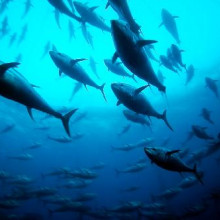
56:20 - Critter of the Week
Critter of the Week
with Carl Safina, Blue Ocean Institute
Carl Safina, president of Blue Ocean Institute, chooses a critter of the week.
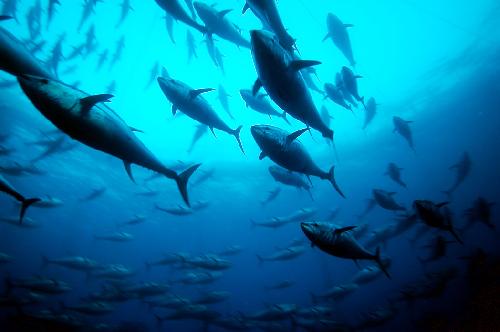 Carl - I'm Carl Safina. I'm an author and President of Blue Ocean Institute at Stony Brook University and the species that I would like to be is a bluefin tuna. It's a huge fish. It's one of the strongest fish in the sea, one of the fastest, and unlike most other fish, it's warm blooded. It's really kind of the king of the fish.
Carl - I'm Carl Safina. I'm an author and President of Blue Ocean Institute at Stony Brook University and the species that I would like to be is a bluefin tuna. It's a huge fish. It's one of the strongest fish in the sea, one of the fastest, and unlike most other fish, it's warm blooded. It's really kind of the king of the fish.
I've seen this fish many times throughout my life and I've always thought it was thrilling to watch them ripping through the surface and exploding as they chase their prey. It looked very powerful, but also like a lot of fun. They seem to really be in command and it seemed like a kind of thing that if you could come back as a fish, that would be the one I want to be.
Find out more
Bluefin tuna (Thunnus Thynnus) info on Fishbase.
Blue Ocean Institute
Carl Safina's blog
Bluefin tuna in crisis. WWF










Comments
Add a comment